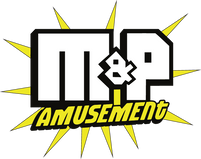
In the age of Xbox and PlayStation, it’s hard to believe that gamers were once forced to leave the house if they wanted to enjoy their favorite game. Indeed, arcades ruled the world of video games during the arcade golden age of the 1980s. It was also during this time that Namco ruled the world of gaming.
Long after arcades fell in popularity — and Namco shifted focus to console gaming — arcade games have remained a source of fun and cherished nostalgia. Let’s look back at the importance of Namco, and how they helped usher in the arcade golden age.
The Origins of a Video Game Pioneer
Originally founded as Nakamura Seisakusho, Namco opened for business in Japan in 1955. With a tenuous business plan and limited portfolio of assets, the company only made small profits until 1959. It was during this year that Namco partnered with Walt Disney Productions and began expanding operations. Namco started by making Disney-themed amusement rides, and later, games.
After their success with Disney, Namco set out to expand their manufacture of coin-operated novelty rides. For the first 16 years of the company, in fact, amusement rides were the primary focus of Namco. It wasn’t until 1971, when Namco shifted to focus exclusively on the burgeoning world of arcade games, that the company found its niche and blossomed.
Namco’s First Arcade Game
The company created its first original arcade game, Gee Bee, in 1977. This first step into the arcade game market was followed by the release of Galaxian — Namco’s first commercial success. The game was hugely influential for its pioneering use of RGB graphics and score bonuses among other unique features.
Namco’s Transformation into an Arcade Giant
Until 1977 Namco was still known as Nakamura Seisakusho. After their initial success in the arcade market, the company changed its name and opened divisions in Hong Kong and North America.
After the success of Gee Bee, the development teams at Namco quickly flung themselves into producing additional arcade hits. This early era would result in commercial successes such as Galaxian, Pole Position, Xevious and Pac-Man.
Galaxian Takes Flight
Galaxian, a fixed shooter game, was released in 1979. Staged as a response to Taito’s Space Invaders, the game was the first major hit for Namco. In the game, players control a starship that is tasked with shooting alien enemies.
The game itself was heavily inspired by Star Wars, with an emphasis on space battles complemented by a dramatic synthesizer soundtrack.
Pole Position Races To Arcades
In 1982, Pole Position followed — a racing simulation that was later licensed to Atari. It was the highest-grossing game in arcades for the years of its release, and it introduced the racing simulation genre to arcades.
While playing, users must complete a lap around a racetrack while trying to beat a time limit. Then, if the player qualifies, they are placed in a race against other vehicles while challenged to stay on the course.
Xevious Blasts The Competition
The same year that Pole Position was released, Xevious hit arcades and provided Namco with yet another commercial success. The vertical scroll shooter game tasked players with controlling a starship which must defend mankind against the attacks of the Xevious.
The game’s detailed graphics and original narrative garnered praise which translated to record-breaking sales across arcades in Japan, Europe, and North America.
Pac-Man Fever Erupts
Pac-Man proved to be the most influential of Namco’s arcade games. It took the world by storm and quickly became an internationally recognizable game. Released in 1980, Namco’s Pac-Man led players through a maze filled with edible dots. Players were required to eat all of the dots while dodging enemy ghosts.
The game’s impact on popular culture was immediately apparent. It inspired an immediate sequel, the acclaimed Ms. Pac-Man arcade game released in 1981. It also inspired songs, merchandise, and a TV show all branded with the titular hero.
Namco’s Console Gaming Years And Decline
After the 80s arcade boom began dwindling, Namco sought to diversify their company’s offerings by venturing into home console gaming.
The arcade boom was followed by the so-called “Famicom boom” of the late 80s. By 1989, 40% of Namco’s revenue came from sales of their games for the NES and Famicom consoles. Namco continued shifting its focus to licensing their titles for console gaming.
Despite their initial success with console gaming, Namco’s sales started to decline by 1998. Consumer spending in North America dropped substantially during this time, and a Japanese recession limited consumers’ availability to play games. After filing for bankruptcy, Namco’s financial losses grew. In 2005, the company was acquired by Bandai and effectively dissolved in 2006.
The Lasting Legacy of Namco Games
Though Namco came to an end, its legacy and cultural impact certainly haven’t. The games it produced are globally recognized as some of the most important games ever created, and their influence on contemporary video games is undeniable.
Perhaps the most notable feature of Namco’s legacy, though, is their quintessential relationship with the 80s. Pac-Man, Galaxian, and Pole Position remain some of the most popular games in today’s arcades. When you think of the 80s and the arcades of that era, you think of Namco.
Shop For Classic Arcade Games From M&P Amusement
M&P Amusement has a huge selection of restored classic arcade games for sale. Whether you want to add something new to your business or you want to add an exciting classic to your home game room, we have classics from all eras!
Our used machines come with warranties and technical support, so you can feel confident in your purchase. Looking for a specific game or have questions? Contact us online or give us a call at 717-887-5293
